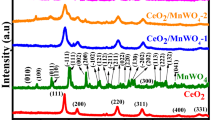Abstract
To unravel the question of how oxide matters in its native metal catalysis, **e’s and Sun’s group from Hefei National Laboratory for Physical Sciences at Microscale, University of Science & Technology of China initially constructed an ideal model of intact metal atomic layer and hence deliberately created its oxide on the surface, forming an oxide/metal atomic layer catalyst mode. Benefiting from the atomic thickness, the built material model enabled most of the metal atoms or metal ions to distribute on the surface. In other words, the abundant surface metal atoms and metal ions could serve as the two typical active sites for involving surface catalytic reactions, hence providing the prerequisite for disclosing the crucial role of surface metal oxide in CO2 reduction of its native metal.
Similar content being viewed by others
References
Rosen BA, Salehi-Kho** A, Thorson MR, et al. Ionic liquid–mediated selective conversion of CO2 to CO at low overpotentials. Science, 2011, 334: 643–644
Zhang S, Kang P, Meyer TJ. Nanostructured tin catalysts for selective electrochemical reduction of carbon dioxide to formate. J Am Chem Soc, 2014, 136: 1734–1737
Chen YH, Li CW, Kanan MW. Aqueous CO2 reduction at very low overpotential on oxide-derived Au nanoparticles. J Am Chem Soc, 2012, 134: 19969–19972
Zhu WL, Michalsky R, Metin Ö, et al. Monodisperse Au nanoparticles for selective electrocatalytic reduction of CO2 to CO. J Am Chem Soc, 2013, 135: 16833–16836
Zhou Y, Tian ZP, Zhao ZY, et al. High-yield synthesis of ultrathin and uniform Bi2WO6 square nanoplates benefitting from photocatalytic reduction of CO2 into renewable hydrocarbon fuel under visible light. ACS Appl Mater Interfaces, 2011, 3: 3594–3601
Liu LJ, Li Y. Understanding the reaction mechanism of photocatalytic reduction of CO2 with H2O on TiO2-based photocatalysts: a review. Aerosol Air Qual Res, 2014, 14: 453–469
Li CW, Ciston J, Kanan MW. Electroreduction of carbon monoxide to liquid fuel on oxide-derived nanocrystalline copper. Nature, 2014, 508: 504–507
Li CW, Kanan MW. CO2 reduction at low overpotential on Cu electrodes resulting from the reduction of thick Cu2O films. J Am Chem Soc, 2012, 134: 7231–7234
Sun YF, Gao S, Lei FC, **ao C, **e Y. Ultrathin two-dimensional inorganic materials: new opportunities for solid state nanochemistry. Acc Chem Res, 2015, 48: 3–12
Gao S, Lin Y, Jiao XC, et al. Partially oxidized atomic cobalt layers for carbon dioxide electroreduction to liquid fuel. Nature, 2016, 529: 68–71
Author information
Authors and Affiliations
Corresponding author
Rights and permissions
About this article
Cite this article
Li, Y. Hybrid atomic layers based electrocatalyst converts waste CO2 into liquid fuel. Sci. China Mater. 59, 1–3 (2016). https://doi.org/10.1007/s40843-016-0114-1
Received:
Accepted:
Published:
Issue Date:
DOI: https://doi.org/10.1007/s40843-016-0114-1




